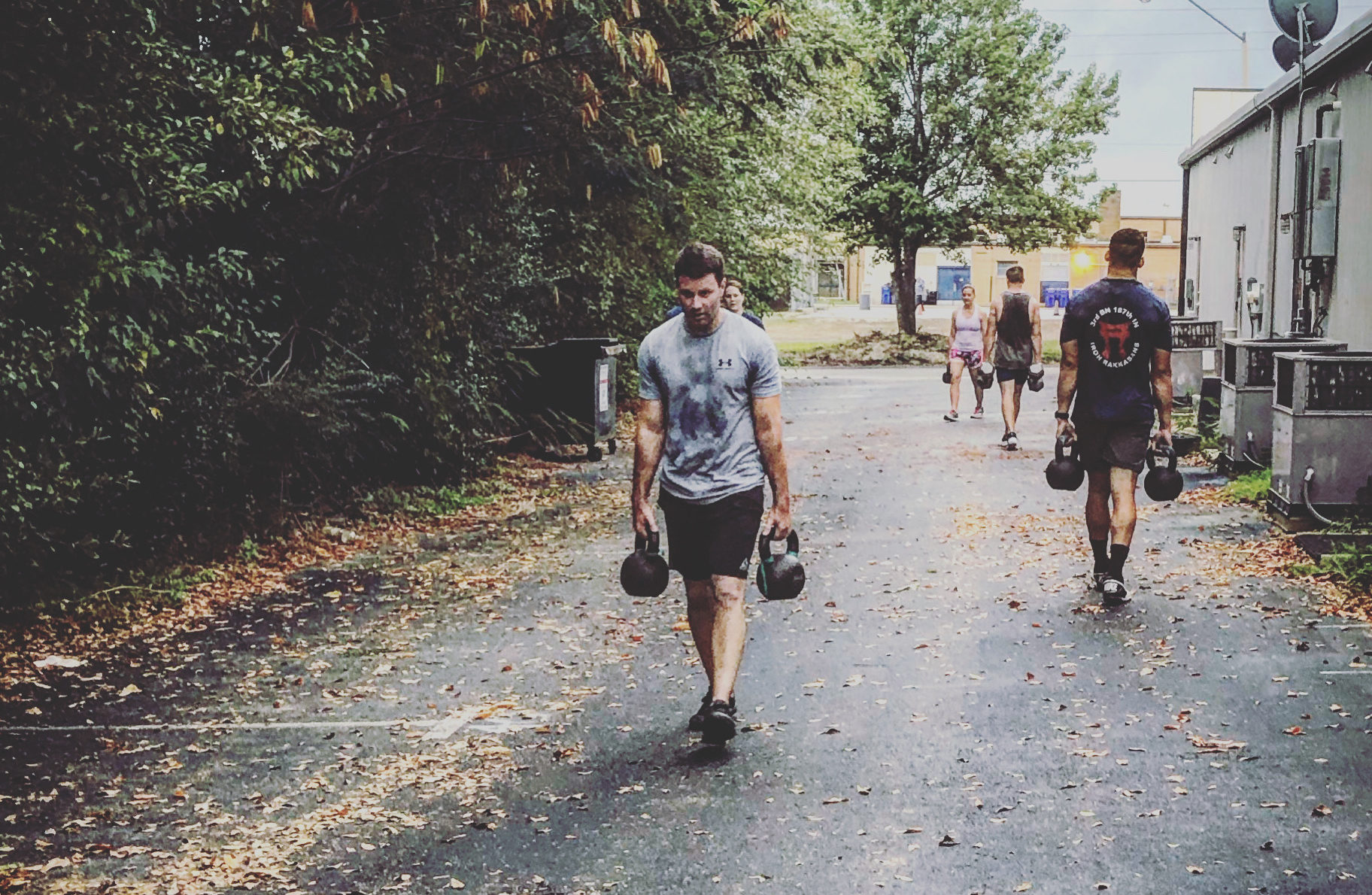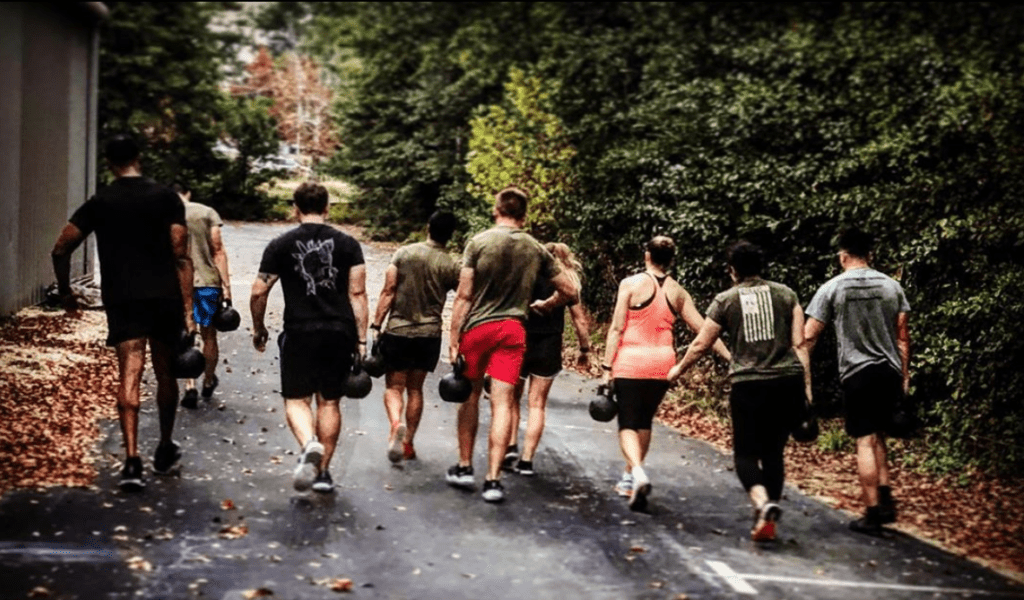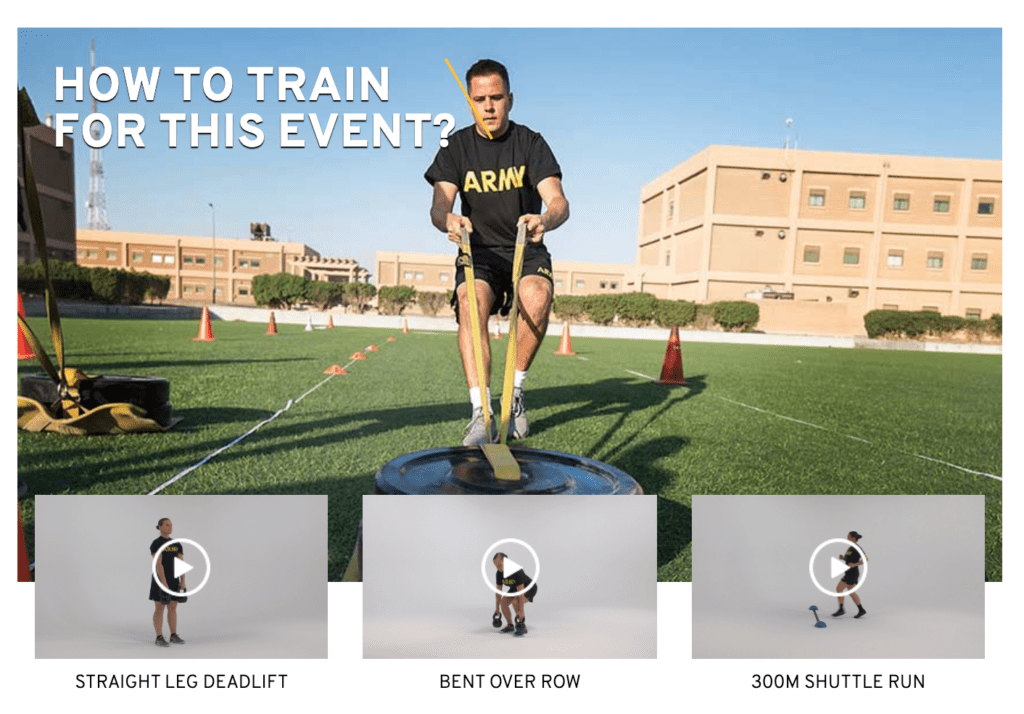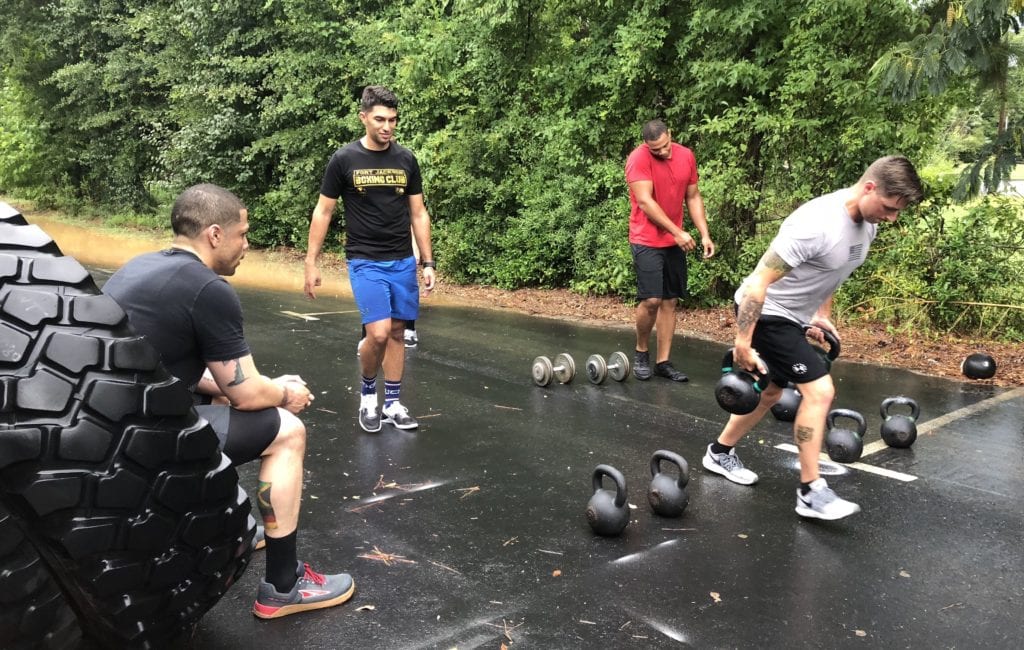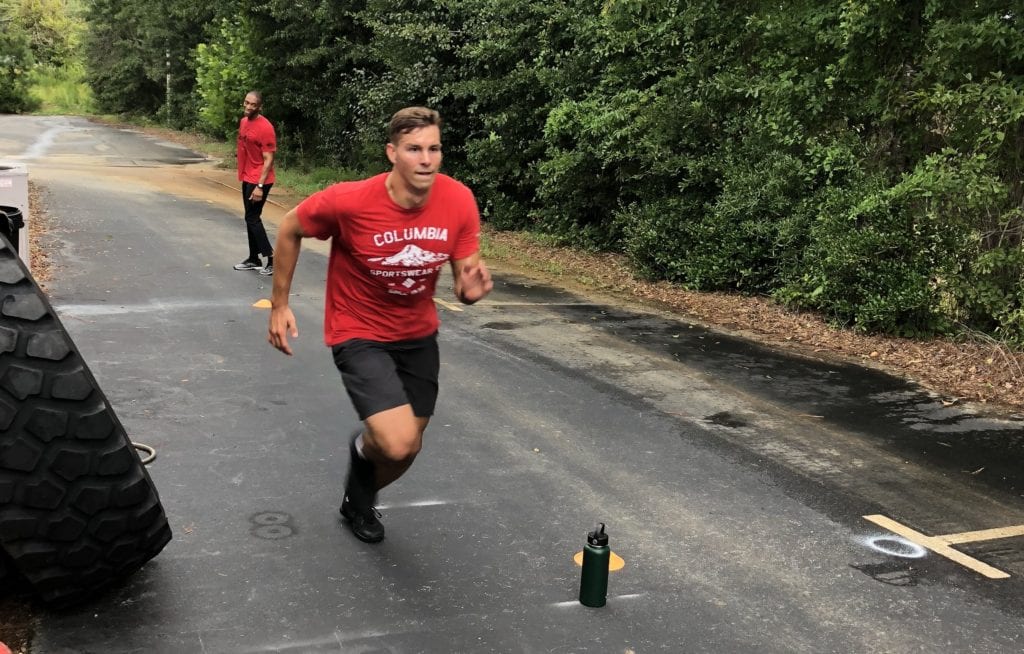12-Week ACFT Train-Up Plan on TrainHeroic!
Hey, before you go any further, if you’re someone that needs help, I got you. My ACFT Train-Up Plan is now only $75. If you’re looking for an ACFT specific train-up program to follow, to get coaching, feedback, questions answered, exercise modifications as needed and to train virally with others I got you. Plus I have been training soldiers for over a decade and have way more than a weekend cert.
Outside of this test having 4-different parts and more equipment involved in it I do really like this test. Like anything, you sit back long enough and you can nitpick the hell out of it. Yeah, it could be simplified a little and accomplish the same goal, but this is what you got and this is what I’ll get you ready for. But when it comes to a test that is “FUNCTIONAL” the Sprint-Drag-Carry (SDC) takes the cake. Plus, if all else fails with your Army career you’ll at least be ready to go crush it on the Supermarket Sweep Reboot coming this year!
Like I said in my last blog about the 3RM Trap Bar Deadlift, hopefully, you have been adjusting your training regiment over the past 6+ months to incorporate some more functional movements. We could go on arguing what is and isn’t functional, but I’m talking about things like lifting weights and not just doing arms, farmer carries, sprints/agilities, intervals, pull-ups/chin-ups, and anything else that can and will help make you an all-around better athlete. So if you’re bored already, just add some loaded carries to your routine and maybe my next blog won’t bore you so much.
The SDC is the fourth event in the Army Combat Fitness Test (ACFT) and in the 70-180+ seconds, it will take you to complete the test you will know immediately who did and who didn’t train for it. One of the things I enjoy about this test is it might be the test that most closely resembles the “functional” movements a soldier may experience in the line of duty. And especially in those moments when the shit is hitting the proverbial fan. Though the SDC has the most moving pieces of any event, it’s not that hard to train for. Don’t get me wrong, it will be hard physically, but the exercises are fairly simple and easy to coach. Anytime you can have a test that is simple to explain and requires virtually no skill it usually will carry the most validity vs a test where there are several elements to be graded and skill is a big component. Yes, there are a few different things you have to do with this test, but all you have to do is sprint fast, drag a sled, carry some KBs and touch each line. Outside of just running a 250m shuttle, this doesn’t get much easier. All you’ll need is a little grit.
*If you’re someone who wants to follow a sound strength & conditioning program geared toward you, the tactical athlete and/or warfighter, delivered daily to your phone for $27/mo, I got you covered. Learn more below!*
The order of the tests in the ACFT will affect how well you perform across the board. If it was a matter of doing all the tests on separate days I think you’d see more 570-600s. But with them, all grouped like they are your conditioning better be on point. With the Leg Tuck (LTK) following the Sprint-Drag-Carry, you can almost guarantee you’ll get fewer tucks if you haven’t trained them back to back. The SDC is going to push your anaerobic capacity to the brink before the LTK event; so the better conditioned you can be on the SDC the better. The LTK has been a nightmare of a test when it comes to passing and failing the ACFT. There is no doubt about it that the LTK is tough and it will only be tougher after you get done with the SDC. If you aren’t strong with pull-ups you better get on top of that ASAP.
But…big congrats to the female soldiers out there. The SDC event, per the ACFT Analytics I have seen, shows that the males are failing the event at a higher rate (5%) than the females (3%). It also was the event where the lowest numbers of females failed in comparison to all the other events. With that being said, it does not mean take this test lightly. Someone asked me why I thought the men failed at a higher rate then the women and my answer was fairly simple. Women are just tough. Some of the toughest people I have ever trained are women. I am always surprised at the punishment that women can take and keep going and then show up the next day and do it all over. Guys R.E.L.A.X. It’s not a dig at you; you’re some tough SOBs too. But when those legs turn into concrete after the first 100yds that’s where we separate the women from the boys. I’m only half kidding.
In all seriousness, let’s get into the best way to train for the SDC. On the ACFT website, they have 3 exercises that they want you to do (see below) to get ready and trained up. I agree with the 300m shuttle and think the other 2 are, well, terrible. Not that they are terrible movements in the world of strength & conditioning but they could’ve come up with 2 better ones. In all honesty, I think they are great, but they sure as hell aren’t going to help you run the SDC any faster. Which at the end of the day is the goal, is it not? So swap out the Bent-Over Row for some Farmer Carries and Drag a Sled in place of the Straight Leg Deadlift. Loaded carries should be a mainstay in virtually everyone’s (athletes and non-athletes) training regiment. If you aren’t doing them, get on it. The 300m shuttle and the sprints and change of direction (COD) demands are one area that has been missing in the Army training for a while. Yes, I’m sure you’ve done sprints, but I bet it wasn’t with any form of regularity and it was for punishment. But with the SDC you can’t hide from focused anaerobic work anymore and with this test, you can make up a lot of time just on your ability to change direction efficiently. And then comes the sled. Pushing and pulling sleds is a serious kick in the gut and can be found in a lot of different styles of programming. By themselves, they are versatile and are a great way to develop power, speed, endurance, and conditioning.
This test and the associated training I just mentioned should make tremendous strides towards improving the overall athleticism of the Army. It’s not going to all of a sudden get you drafted to the NFL, but there will be marked changes in a soldier’s ability to move fast, stop and change direction. Plus, it will help reduce the likelihood of injuries. Below I’ll touch on the 300m Shuttle, Farmer Carries and Sled Drags to help you go leave your coworkers in the dust.
How to Actually Train for the ACFT Sprint-Drag-Carry…
300m Shuttle:
I’ve had soldiers running these for over a decade across a variety of sports and there is a reason USASOC uses it as one of their performance metrics within the THOR3 program. And if you can only do one thing to train for the SDC this should be it. Really? YES! It’s very simple to set-up, minimal instruction is required and very simple to execute. Set two cones 25m apart, exactly the distance you’ll be running on the SDC, and sprint back and forth 6 times to equal 300m. That my friends are the definition of simple. The goal of these shuttles is to increase your anaerobic capacity. Anaerobic capacity (AC), in the simplest of terms, is the total amount of energy you are able to generate without oxygen. What does that mean exactly? Pretty much any short duration, a high-intensity activity that you can think of will be taxing your anaerobic energy system. So basically anything that requires your maximum effort between 0:01 seconds to ~3:00 mins falls in that window. The 300m Shuttle and Sprint-Drag-Carry both accomplish that. Other exercise examples would be sprints, agility/COD drills, intervals, explosive weightlifting, and plyometrics.
The amount of rest you take between efforts is a large determining factor of if you are getting faster and/or increasing your anaerobic capacity or if you are just working out mindlessly. Remember, this is about TRAINING for the test, not working out. There is a big difference. So for all speed-based intervals, you should be resting way more than you think. Granted, everyone is different based on the training level, but the work-to-rest ratio is vital. It can be anywhere from 1:2 to 1:6. What that means is if the 300m shuttle takes you 60 seconds to complete you would rest 120 seconds (1:2) minimum before your next rep. If you are actually going at 100% effort, you will not be able to run faster in the 2nd effort. Physiologically that is impossible if you’re giving 100% effort unless you are sandbagging your first rep and/or you are blood doping.
“The faster you run, the faster it’ll be over.”
My biggest piece of advice that I can give to you with the 300m Shuttle is run as hard as possible. If you aren’t running as hard as possible, you will not be maximizing your potential gainzzz. There is a big difference between 90% and 100% effort. Yes, times will be slower on the 2nd rep, 3rd rep, etc, but you need to run it like you can beat your previous time and I promise you, you will crush the SDC. This is one of the hardest and most uncomfortable ways to train, but it is also one of the most beneficial. Suck it up, the faster you run the quicker it’ll be over. A good place to start with this is with 2 sets of 1 rep (1 rep = 300m Shuttle), with a work to rest ration of 1:6. And over time decrease your rest, 1:6 down to 1:2, etc. Run a 300m, rest, then run another 300m. Simple. Effective. Done in fewer than 10 minutes.
Farmer Carries (Walks):
Some people call them Suitcase Carries, I don’t. I grew up in a blue-collar family on the blue-collar side of Rochester NY; its Farmer Carries (Walks) in my book. Also, as someone who just traveled home through a few airports, I didn’t see anyone carrying a suitcase. They all have fancy 360-degree wheels now so it’s more like a suitcase drag or push. Now there are a plethora of carrying variations that I love to program for my Tactical Athletes. The gold-standard being the 2-KB or 2-DB Farmer Carry. It’s very simple, pick up heavyweight and start walking, but for the test, you’ll need to be pushing it a little faster. Either implement will get the job done for training, but there is a big difference between what it feels like carrying a KB vs a DB. To see the difference, grab a KB and DB of the same weight and do a farmer carry. Your little wrist muscles got to work much harder on the DB side. But both are effective and if you only have DBs to train with when you get to the test you’ll feel like it’s cheating using KBs.
I love the Single-Arm Carry as well. It’s one of my favorite exercises to challenge grip strength, core control, and balance. Plus it is one hell of an injury prevention tool. Just don’t lean to the side. That’s one of the common mistakes. People pick up something heavy and just let the weight pull them over. Stand tall and try to keep your shoulders parallel to the floor. I also like mixing it up with a Single-Arm Carry and adding something to the other hand/arm. Maybe a DB overhead, pinching a plate between your fingers, squeezing a Medball to your body or carrying a KB with a band or even a Waiter Carry with a plate locked out overhead. All of them will help you not just on the test, but also challenge your core in a way sit-ups won’t. I call those variations Awkward Carries because they are in fact awkward. With all of these carries, the easiest way to do it is to pick a distance and do a couple of sets. Let’s just say 3-5 sets of 50 yds (25 yards out and back) to start with. Don’t forget to rest (60-90 seconds) or make it a little circuit by throwing in some Hand Release T-Push-Up or Elbows to Knees V-Ups with the carries or set a clock for 6-10 minutes and get in as many rounds as possible.
Sled Dragging:
Surprise, Surprise. Who would’ve thought to include sled dragging as a way to get better at the SDC? Talk about low hanging fruit. I don’t know why the ARMY chose not to include this in the 3 exercises to train up for the SDC but talk about a mistake. If you have dragged the 90 lb sled already you understand what it feels like and how tough it is when your legs feel like cement is coursing through your veins. I know that not everyone has access to a sled, but if you have a few bucks and are a little handy I can help you build your own sled. See below for some instructions.
I’ve been in plenty of the gyms on and off of the base and know that they have all sorts of sleds at your disposal. Plus the majority of globo gyms and CrossFit gyms around now have a little turf and a sled you can use. When it comes to training for the event, the sled doesn’t matter too much, just as long as you are getting used to working the muscles that are going to be working by dragging the sled backward. Now it is important to note that when dragging the sled you need to be facing the sled and moving backward. Specificity is the fancy term that you can use here. If you only ever push a sled or pull facing away from it you are doing yourself a massive disservice in your preparation for the SDC. It’s ok to mix it up with how you use the sled, but just be sure the majority of reps are moving backward for the carryover to the test.
“Stay low, move fast.”
One of the great things about the sled is the diversity of training that you can do with it. Based on the load and duration of use, you can hit a number of different adaptations. Durations of 60-90+ seconds can work more muscular endurance, hypertrophy, aerobic energy system, 30-60 seconds can help develop strength and increase hypertrophy, with sprint’s of 5-30 seconds working on improving speed and improving the anaerobic energy system. The simplicity of this exercise makes this a straightforward and low-risk movement for all fitness levels, which is great because there is a wide variety of fitness levels in the Army. If you have ever had a training session with sled pulling in it, you know how the whole body pulling a sled can be. The legs, glutes, core, back, shoulders, and arms are all working the entire time whether you’re going fast or going slow. The versatility of the sled makes it a great training tool. So if you’re not using one currently, throwing some sled work in once a week is a great idea!
Now with all that said, for the ACFT sled drag, you’ll be covering 50 total yards (25 out and back) on the test. So when training up for it, getting in a few sets and reps weekly of 50 yards is a great place to start. Be sure you are working on the turn around aspect of the test too. There are valuable seconds that can be made up and/or lost when turning around. Let us say 5-8 sets of 1 rep (25 yards out and 25 yards back). Resting 1-2 minutes. Just like with the 300m, your goal should be to move as fast as possible. There is nothing leisurely about this test so don’t train that way.
“If you waste movement, you waste time.”
We covered sprinting and change of direction with the 300m Shuttle, we touched on the loaded carry portion with the Farmer Carries and we took care of the sled portion with the Sled Dragging. I know there is a lateral shuffle portion as well. This isn’t something that needs to be specifically trained for with its own dedicated block in a training session. So if you just throw some lateral shuffles in your warm-up daily you should have no issues on the test. The biggest thing is to stay low and move fast. Also, try not to look around a bunch when doing it, that’s typically when people trip and fall. Pick a spot to look at and look for the line or cone in your peripheral vision. When it comes to the testing day you’ll probably be thinking about a million different things with this test. But the most important piece is to be as efficient as possible with your movements. You will make a total of 11 turns over the course of this test, so if you stumble and it takes you 2 extra seconds each turn, that’s 22+ seconds you conceivably lost. So stay low, get over the lines, touch the lines, set the kettlebells down properly, pull the whole sled over the line on the first try. Don’t waste movement.
If you want to take all the guesswork out of your daily training regiment, or if you’re looking for an ACFT Train-Up plan to follow, the easiest and smartest thing you can do is join one of our Online Training Teams for less than a $1 a day or buy access to our 12-Week ACFT Train-Up Plan. Learn more at the link below.
Items to Build your Own Sled:
- Used Tire (free at most tire shops) or Sled
- Hefty Style Garbage Bag (fill with rocks, sand, etc)
- Duct Tape
- Ratchet Straps or Paracord/Parachute Cord (you know there is some lying around at work)
You can buy your own sled and spend $100s or you can go to the local tire shop and snag a few used ones for nothing. Most tire shops will just give them to you so they don’t have to pay the recycling fee. Plus I know there are plenty lying around the base. The sled I have a link to is under $10 so you can make it work. You’ll need a heavy-duty garbage bag for weight. Now it is up to you with what you want to fill it with. You can find a bag of stone or sand at any local hardware store or you could just go out back with a shovel and put dirt in it for free. Then use the duct tape to reinforce the bag. I’d suggest filling 3 bags so you can have an adjustable weight. Now go talk to your friendly rigger and ask for some paracord. You can do 1of two things, drill a hole in the tire to tire the straps too or you can just wrap it around the entire tire. The choice is up to you. From there, throw the weight inside the tire(s) and start pulling. Pretty simple if you have 30 minutes of time. Conceivable you can build this for free if you’re creative and nice haha. I’ll work on getting some photos, but you are all smart enough to figure it out.
Need Help? Just ask…Seriously.
I hope this can help some of you out there. If you have questions let me know geoff@gpshumanperformance.com
Geoffrey Steinbacher is a former Strength & Conditioning Coach within the THOR3 (Tactical Human Optimization Rapid Rehabilitation & Reconditioning) Program at Ft. Bragg. He is a Certified Strength and Conditioning Specialist (CSCS) from the National Strength and Conditioning Association, as well as a Certified Athletic Trainer (ATC) from the National Athletic Trainers Association. He is also an Advanced Sports Performance Coach (USAW-L2) and Head Club Coach with USA-Weightlifting, and a Catalyst Athletics Certified Weightlifting Coach (CACWC-L1). Furthermore, Geoff has a BS in Athletic Training from SUNY Cortland and an MS in Exercise Science from Syracuse University.
ACFT Handbook Description/Standards Below:
Sprint-Drag-Carry (SDC) is a measure of muscular power, endurance, and strength, and anaerobic capacity, which are needed to accomplish high-intensity combat tasks that last from a few seconds to several minutes. This capacity contributes to a Soldier’s ability to react quickly to direct and indirect fire, build a hasty fighting position, and extract a casualty from a vehicle and carry them to safety. The NCOIC will serve as the starter for the SDC. All lanes will start on the command “GO.” Individual graders will time their lane.
- When the NCOIC gives the command “GET SET,” one Soldier in each lane will assume the prone position with the top of the head behind the start line. The grader is positioned to see both the start line and the 25m line. The grader can position a Soldier/battle buddy on the 25m line to ensure compliance with test event standards. Sled weight is 90 lbs.
- Sprint: when the NCOIC gives the command “GO,” Soldiers stand and sprint 25m; touch the 25m line with foot and hand; turn and sprint back to the start line. If the Soldier fails to touch the 25m line with hand and foot, the grader watching the 25m turn line will call them back.
- Drag: Soldiers will grasp each strap handle, which will be positioned and resting on the 90lb sled behind the start line; pull the sled backward until the entire sled crosses the 25m line; turn the sled around and pull back until the entire sled crosses the start line. If the entire sled does not cross the 25m or start line, the grader watching the 25m turn line will call them back.
- Lateral: after the entire sled crosses the start line, the Soldier will perform a lateral for 25m, touch the 25m turn line with foot and hand, and perform the lateral back to the start line. The Soldier will face the same direction moving back to the 25m start line and returning to the start line so they lead with each foot. Feet may shuffle and touch, but should not cross. If the Soldier fails to touch the 25m turn line with hand and foot, the grader watching the 25m turn line will call them back. Graders will correct Soldiers if they cross their feet.
- Carry: Soldiers will grasp the handles of the two 40lb kettlebells and run to the 25m turn line; step on or over the 25m turn line with one foot; turn and run back to the start line. If the Soldier drops the kettlebells during movement, the carry will resume from the point the kettlebells were dropped. If the Soldier fails to touch the 25m turn line with their foot, the grader watching the 25m turn line will call them back.
- Sprint: after stepping on/over the start line, Soldiers will place the kettlebells on the ground; turn and sprint 25m; touch the 25m turn line with foot and hand; turn and sprint back to the start line. If the Soldier fails to touch the 25m turn line with hand and foot, the grader watching the 25m turn line will call them back.
Graders will correct Soldier performance that may result in injury to include:
- Jerking the straps or slinging the sled to turn the sled around.
- Crossing the feet during the Lateral.
- Failure to turn under control after picking up kettlebells.
- Throwing the kettlebells.
Graders will call Soldiers back to the start line or the 25m turn line to correct violations in performance to include:
- Failure to touch the line with a hand and foot while sprinting or doing laterals.
- Failure to pull the entire sled across the 25m or start line; Soldier’s body must cross the line pulling the sled backward until the entire sled crosses the line; Soldier may then turn the sled.
- Failure to pull the entire sled across the start line before beginning the laterals.
- Failure to place the kettlebells on the ground under control; Soldiers may not throw or toss the kettlebells.
The time is stopped when the Soldier crosses the start line after the final sprint (250 meters).
